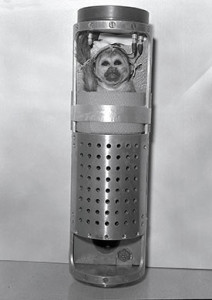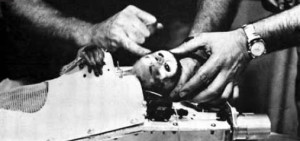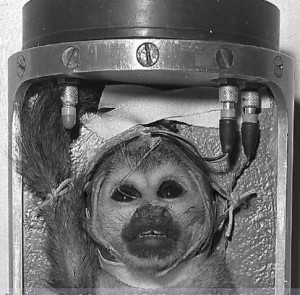By Michael Collins – First of two parts
Pasadena Weekly cover story “Space Monkey Business” with the cover art.
READ our questions for squirrel monkey radiation experiment project head, McLean Hospital’s Dr. Jack Bergman, and the hospital’s response in “Space Monkey Business Q & A.”
SEE the People for the Ethical Treatment of Animal’s petition page asking NASA not to experiment on the squirrel monkeys in order to gauge radiation’s effects on humans in space.
SEE the Physicians Committee for Responsible Medicine petition page asking NASA Administrator Charles Bolden, Jr. to stop the use of monkeys in space radiation studies.
SPACE MONKEY BUSINESS
Critics say NASA is taking a giant leap backwards by irradiating monkeys in space-travel tests
Pasadena Weekly – February 25, 2010
The future of manned space exploration was revealed Feb. 1 when President Obama unveiled his 2011 budget request for NASA. The president proposed ending the Constellation program, an initiative introduced by President Bush in 2004 to take Americans back to the moon by 2020 and to Mars beyond.
Obama’s grounding of the manned space program has unleashed a torrent of criticism that could gut the move to prioritize robotic missions and technological advancements rather than planting flags on the moon. Nowhere will the impact of how the great space debate plays out be more pronounced than at Pasadena’s Jet Propulsion Laboratory.
But far from JPL, 18 sociable monkeys sit in cages at the NASA Space Radiation Laboratory in Upton, NY, where they will be injected with gamma radiation by scientists who contend that the results can be correlated to humans facing long outer space flights through fields of intense cosmic radiation.
The budget’s approval by Congress will determine the future of these squirrel monkeys in the $1.75 million experiment to see how much radiation the critters can take. Animal testing of this sort hasn’t been done in nearly three decades. While officials maintain they will follow all institutional, state and federal guidelines in caring for the monkeys, some animal rights groups are outraged.
“NASA prides itself on looking to the future, but when it comes to crude and cruel animal experiments, the agency is stuck in the Dark Ages,” said People for the Ethical Treatment of Animals Vice President of Laboratory Investigations Kathy Guillermo in a statement on PETA’s Web site. “Monkeys are highly social, sensitive and intelligent animals. Harming them in experiments so that NASA can check off another item on its seemingly endless list of questions about outer space is unjustifiable, especially when modern, humane research methods exist.”
Radiation overload
The monkeys are a small but important cog in determining the future of the space agency, now that Obama has proposed ending manned space flight to the moon and Mars. Critics contend that the astronomical amounts of money saved from trying to ferry humans to outer space will result in better and more robust robotic exploration of the heavens. Supporters of Constellation counter that it has already cost $9 billion, which would be wasted along with the $2.5 billion more it will cost to shutter the program, throwing thousands out of work in the process.
President Obama has a fight on his hands with Congress over this radical departure from NASA’s focus. Last year, lawmakers made cutting Constellation programs subject to their approval. That provision sent a “direct message that the Congress believes Constellation is, and should remain, the future of America’s human space flight program,” wrote Sen. Richard Shelby, R-Ala., in December.
America’s manned space program is at a crossroads. Most if not all NASA missions can be completed robotically, leaving Constellation supporters with the main argument that human exploration inspires the nation. That powerful notion worked during the Cold War, but may not now, considering the astronomical cost of keeping people alive in the forbidding environment of space.
The monkeys’ fate, however, may lie in information the Pasadena Weekly found, which NASA has either missed or ignored: Italian experiments on the International Space Station involving astronauts wearing special helmets to measure cosmic radiation exposure, which seem to obviate the need to nuke the monkeys.
Even with remarkable technological advancements since NASA’s outer space heyday of the Apollo program, one of the only known ways to protect against this kind of radiation is still lead shielding. The heavy metal would be required in spacecraft and astronauts’ suits and would render spacecraft and astronauts too heavy to be practical for long space flights.
The National Research Council cautioned in early 2008 that present technology to protect against space radiation “would not allow a human crew to undertake a Mars mission and might also seriously limit long-term moon activity.”
Cosmic rays consist of high-energy protons and other nuclei so intense that the Apollo astronauts reported seeing flashes in their eyeballs. The 24 astronauts who made up the Apollo program, the only men ever to have gone into deep space, are too small a number statistically to be scientifically representative, but it is thought that they have suffered an above-normal rate of cancer.
Plus, the longest flight the Apollo astronauts rode on was less than two weeks, not the months needed to travel to Mars.
Estimates of radiation exposure in outer space do exist. An unshielded interplanetary astronaut would receive about 400 to 900 milli-Sieverts (mSv) annually, compared to 2.4 mSv on Earth. Even a “shielded” mission to Mars lasting 30 months would irradiate humans with up to 1,000 mSv (1 Sv), which is approaching the lifetime limit, 1 to 4 Sv, advised for so-called “low-Earth orbit activities” of astronauts, as determined by the National Council on Radiation Protection and Measurements.
To be totally effective against both galactic cosmic rays and higher energy waves, any known shielding would weigh hundreds of metric tons. Even that shielding can cause reflective “bounce back” or secondary radiation exposure. The radiation in outer space is intense, especially during solar proton events when the sun emits a solar flare or coronal mass ejections.
Irradiating 18 squirrel monkeys to test their cognitive responses suggests that NASA knows it won’t be able to adequately shield astronauts living on the moon and traveling to and from Mars. If the monkeys perform effectively even after being dosed with a massive shot of gamma radiation, the argument could be made that humans could do the same.
‘Pretty much on target’
In the study, the monkeys will be shot up with a single substantial dose of gamma radiation, which NASA’s project leader, Dr. Jack Bergman of Harvard Medical School’s McLean Hospital near Boston, insists would simulate what a human would receive over the 130 to 260 days it would take to travel to and explore the Red Planet.
“We realized there was a need for this kind of work,” Bergman told Discovery News reporter Irene Klotz for an Oct. 29 article titled “NASA To Start Irradiating Monkeys — Spider monkeys will be exposed to regular, low dose radiation as NASA investigates the effects of long term space travel.”
“There’s a long-standing commitment on the part of NASA to deep space travel and with that commitment comes a need for knowing what kinds of adverse effects deep space travel might have, what are the risks to astronauts,” Bergman continued. “That’s not been well-assessed.”

Along with confusing spider and squirrel monkeys, the subheadline of the article is inaccurate in two significant ways: the monkeys won’t be exposed to “regular” radiation, but rather one massive gamma radiation injection, and the radiation is not “low dose,” as the dose is supposed to simulate months worth of “HVE,” or high energy particles of high atomic number, that people exploring the moon or traveling to Mars would experience zipping through them.
Bergman’s statement that the risks to astronauts have “not been well-assessed” is also suspect. The risks have been assessed and they are significant. President Bush stated this when he announced the initiative.
Another article for Discovery News penned five months earlier by the same reporter, titled “Space Torso Reveals Cancer Risk for Astronauts,” says, “‘The information collected so far confirms that NASA’s current guidelines for assessing radiation risks are pretty much on target,’ said Francis Cucinotta, a doctor and researcher who heads radiation studies at the Johnson Space Center in Houston.”
So if the risk assessments are “pretty much on target,” why would NASA spend $1.75 million on Bergman’s experiments to nuke 18 squirrel monkeys? The answer may lie in a passage later in the article: Cucinotta figures the agency has about five years to come up with some solutions to the radiation problem or find evidence that refutes current assessments of the risks (our emphasis). More shielding on moon and Mars ships probably isn’t the answer, Cucinotta told Discovery News. The additional weight would make the spacecraft too heavy to launch with today’s technologies.
That evidence could be obtained by showing that the monkeys essentially shake off the radiation and continue to perform tasks effectively, since shielding and gene-repairing pharmaceuticals seem out of the question.
“We’d all be cured of cancer on Earth if we knew how to do this,” Cucinotta told Discovery News of the use of drugs to diminish radiation damage. No pill can stop deadly radiation from destroying human and monkey cells.
The Sundowner Report
PETA, which claims two million members, has tried to publicize the impending experiments, citing the disturbing effects that irradiating monkeys can have, including inducing fatal cancers, brain tumors, cataracts, teeth falling out, cognitive decline and self-mutilation.
“In the 1950s, chimpanzees were taken from their natural habitat, kidnapped from their families, and used as crash-test dummies in experiments in which they had their necks broken and their skin burned off and were severely maimed for the purposes of testing missiles, helmets and windshields,” wrote Justin Goodman, research associate supervisor for PETA’s Laboratory Investigations Department in a Nov. 4 letter to NASA Administrator Charles F. Bolden Jr. “Since then, hundreds — perhaps thousands — of monkeys have been exposed to dangerous levels of radiation and others, some of whom had their tails chopped off, have been launched into space on ill-fated missions that caused them to suffer from brain damage, heart failure and other health complications from which they never recovered.”
PETA’s plan to derail the primate research in the face of scant public awareness has received a boost from a nonprofit group called the Physicians Committee for Responsible Medicine, or PCRM.
The group filed a federal petition for administrative action in November seeking to force the government to halt the squirrel monkey experiments because they violate NASA’s “Principles for the Ethical Care and Use of Animals,” also known as the Sundowner Report. The petition notes that the space agency has not used monkeys for radiobiology research in decades. The PCRM’s Web site has a page where the public can petition Bolden to halt the project.
“Irradiating monkeys would be one giant leap backward for NASA,” wrote Dr. Hope Ferdowsian, PCRM’s director of research policy, in the petition. “The proposed experiments are cruel, unnecessary and lack scientific merit. There are better, more humane ways of understanding the potential dangers of interplanetary travel to humans. Scientific progress can only proceed with a strong ethical foundation.”
The group’s petition for administrative action says that the radiation experiments will violate the standards of the Sundowner Report, a landmark 1996 NASA document that requires researchers to respect living creatures, consider the full range of societal good that may come from an experiment and utilize non-animal methods whenever possible.
“Genetic, physiological and anatomical differences between humans and monkeys dramatically limit the conclusions that can be drawn from the planned experiments,” the petition states.
“Ongoing studies, including those funded by NASA and the US Department of Energy, already use non-animal methods to determine the effects of low-dose radiation on human tissues.”
PCRW takes particular aim at the experiment’s originator, Bergman, as the NASA-funded researcher who “would involve irradiating monkeys and testing them to see how they perform on various tasks,” wrote Ferdowsian. “Bergman has used squirrel monkeys for 15 years in addiction experiments, which have involved applying electric shocks, withholding food and completely immobilizing the animals in restraint chairs for extended periods.”
Bergman’s profile on the Harvard Clinical and Translational Science Center Web site lists 122 publications that document experiments with such titles as “The effects of electric shock on responding maintained by cocaine in rhesus monkeys” and “Drug effects on primate alarm vocalizations.”
A 1994 study, “Discriminative stimulus effects of caffeine in methamphetamine-trained squirrel monkeys,” seems bizarre on the face of it while another Bergman report, published in 1997, has a particularly ominous title: “Back to the Future. A Commentary on Animal Models of Anxiety: Where Next?”
Outer space, it would seem, but the monkeys headed for the hot seat will have to endure their earth-bound experiments in a high-tech bunker at NASA’s Space Radiation Laboratory at the Department of Energy’s Brookhaven National Laboratory in New York.
That is if public outrage doesn’t corral the simian-sacrificing agency, which claims that the monkeys will not be killed and will remain at McLean Hospital, where they will be overseen by veterinarians and staff.
“The beauty of this is that we can assess at different time points after exposure, so not only do we get a sense of rather immediate effects, but then we can look again at longer time points,” Bergman told Klotz. “That kind of information just hasn’t been available.”
But this statement holds little merit considering that monkeys are biologically different enough from humans that the results of these experiments cannot be readily correlated between the species other than that radiation will kill both after extremely painful tumors and other cancers. Effects of massive radiation exposure have been well documented in studies going back to the early 1950s.
An Italian experiment on the International Space Station began last summer and is described on the NASA Web site as “Anomalous Long Term Effects in Astronauts’ Central Nervous System,” or ALTEA. According to a NASA Web site page, ALTEA “will be able to “discriminate the type of particles, to measure their trajectories and the delivered energies. This will provide in-depth information on the radiation experienced and its impact on the nervous systems and visual perception. ALTEA will also develop new risk parameters and possible countermeasures aimed at the functional central nervous system risks.”
“The neurophysiologic effects of cosmic radiation in long-term space travel have never been explored with the depth of the ALTEA experiment,” reads the ALTEA page on the NASA site. “Data collected will help quantify risks to astronauts on future long distance space missions and propose optimized countermeasures.”
Presumably, the folks at NASA are aware of this experiment, which is looking for the very same answers that the squirrel monkey study ostensibly is. But there is a major difference between the Italian and American experiments: the Italians are studying the actual animals that tests are meant for — humans, not monkeys.
If the Constellation program is discontinued, inhumane primate experiments and the exorbitant and expensive dreams of human space conquest may disappear into a stellar black hole. It could be one small step for monkeys, one giant leap for robots.
Next week: “We Robot” finds that JPL, home of America’s greatest robotic explorations of the heavens, isn’t sold on deep-sixing the manned space program.
Contact the author, Michael Collins, at EnviroReporter.com.














Recent Comments